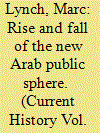| Srl | Item |
| 1 |
ID:
087839


|
|
|
|
|
| Publication |
2009.
|
| Summary/Abstract |
Among multiple aspects of Israeli dominance over the Palestinians from
both sides of the Green Line, the ideological one appears as the single most
spectacular failure. Members of the Israeli establishment readily acknowledge
the notorious inefficiency of the Israeli public relations campaign in
Arabic.1 Although the Israeli Broadcast Authority (IBA) maintains radio
and TV broadcasts-and even attempted for a short while to launch a
Middle East Satellite Channel (2002-2005)-the overall impact of these
efforts on shaping Palestinian or, more generally, Arab public opinion
is negligible.2 The reasons for this failure are not difficult to assess: even
for the most sophisticated public relations campaign it would be difficult
to market Israel to the hostile Palestinian and Arab audience, particularly
to those who are direct victims of either occupation or discrimination.
But does this mean that efforts to present Israeli viewpoints to the Arab
public are meaningless and intrinsically doomed? To examine this
supposition, this article will analyze one of the most interesting attempts
of the Israeli authorities to communicate with the Palestinians through a
printed medium: the first seven years of the seventeen-year long life of
al-Anbaa (The News) newspaper (1968-1985).
|
|
|
|
|
|
|
|
|
|
|
|
|
|
|
|
| 2 |
ID:
155848


|
|
|
|
|
| Summary/Abstract |
The early Soviet Union, the People’s Republic of China (PRC), and independent India inherited vast territories and multi-ethnic populations from the preceding empires. Their maintenance was a political and administrative challenge. The Soviet Union devised an archetype of ethnoterritorial federalism, in which nationality groups were granted their own administrative territories and subnational governments. The PRC and India imitated this system selectively, aware of its dangerous centrifugal tendency. The collapse of the Soviet Union discredited ethnoterritorial federalism, but none of the three countries has since devised a new system of multinational integration to replace it.
|
|
|
|
|
|
|
|
|
|
|
|
|
|
|
|
| 3 |
ID:
143221


|
|
|
|
|
| Summary/Abstract |
Unipolarity is arguably the most popular concept used to analyze the U.S. global position that emerged in 1991, but the concept is totally inadequate for assessing how that position has changed in the years since. A new framework that avoids unipolarity's conceptual pitfalls and provides a systematic approach to measuring how the distribution of capabilities is changing in twenty-first-century global politics demonstrates that the United States will long remain the only state with the capability to be a superpower. In addition, China is in a class by itself, one that the unipolarity concept cannot explain. To assess the speed with which China's rise might transform this into something other than a one-superpower system, analogies from past power transitions are misleading. Unlike past rising powers, China is at a much lower technological level than the leading state, and the gap separating Chinese and U.S. military capabilities is much larger than it was in the past. In addition, the very nature of power has changed: the greatly enhanced difficulty of converting economic capacity into military capacity makes the transition from a great power to a superpower much harder now than it was in the past. Still, China's rise is real and change is afoot.
|
|
|
|
|
|
|
|
|
|
|
|
|
|
|
|
| 4 |
ID:
142144


|
|
|
|
|
| Summary/Abstract |
Arab politics will be torn for many years to come between the restless, critical power of the public sphere and the determined efforts of regimes, states, and old elites to maintain their domination.” Third in a series on public spheres around the world.
|
|
|
|
|
|
|
|
|
|
|
|
|
|
|
|
| 5 |
ID:
170599


|
|
|
|
|
| Summary/Abstract |
The present paper discusses the so-called “Russian factor” in the political development of Japan over a period from the late 19th century till the present day. The rise and fall of Japan as a “great power” in the 20th century is tightly linked with its relations with Russia (the Russian Empire and the USSR), which became a specific factor of the Japanese imperial project. Russia served as a challenge to Japan that triggered its social mobilization and militarization in 1895-1905. The victorious Russo-Japanese War made Japan a “great power” with colonies on the continent. However, it also predetermined the political rise of its military circles, which ultimately worked as a time bomb breaking the foundation of the newborn empire. Cooperation with Russia after 1906 was the most effective instrument for Japan’s further expansion on the continent, while the intervention into Siberia after 1917 came as the first alarm signaling the limits of that expansion. The paper also examines the harsh geopolitical rivalry between the two countries during the 1930s, “strange neutrality” during WWII, and the Soviet-Japanese war in August 1945 as the final factor that brought Japan to a surrender and drove the final nail in the coffin of its imperial project. The study shows an unprecedented transformation of Russia’s image in Japan over the years and analyzes the Russo-Japanese territorial dispute in a new perspective.
|
|
|
|
|
|
|
|
|
|
|
|
|
|
|
|